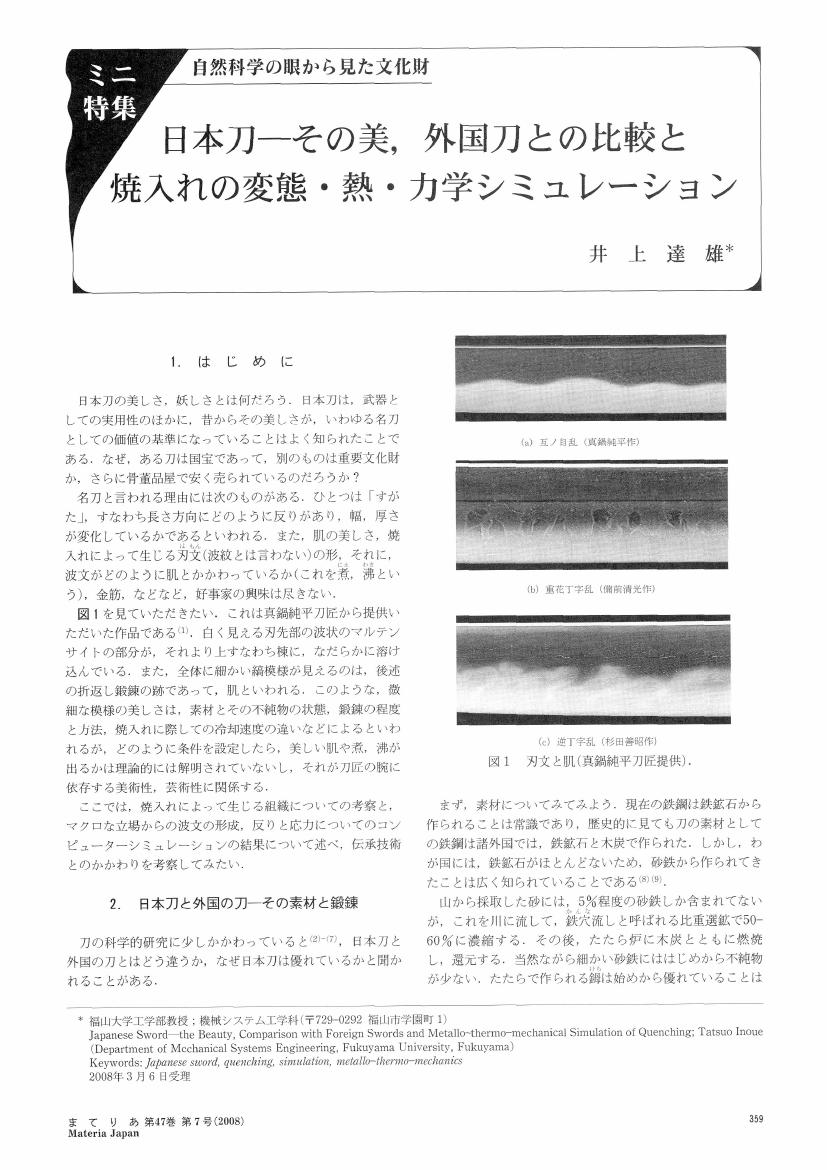18 0 0 0 OA 日本刀に息づく科学と技術
- 著者
- 井上 達雄
- 出版者
- 公益社団法人 日本材料学会
- 雑誌
- 材料 (ISSN:05145163)
- 巻号頁・発行日
- vol.66, no.11, pp.804-810, 2017-11-15 (Released:2017-11-20)
- 参考文献数
- 10
- 被引用文献数
- 1
6 0 0 0 OA 日本刀の焼入れにおける焼刃土の効果
- 著者
- 上原 拓也 井上 達雄
- 出版者
- 公益社団法人 日本材料学会
- 雑誌
- 材料 (ISSN:05145163)
- 巻号頁・発行日
- vol.44, no.498, pp.309-315, 1995-03-15 (Released:2009-06-03)
- 参考文献数
- 19
- 被引用文献数
- 4 9
The quenching process of a Japanese sword is simulated by a CAE system “HEARTS” developed by one of the authors. The system is available to consider the coupling effect among metallurgical change due to phase transformation, temperature and inelastic stress/strain.In the quenching process of the Japanese sword, a special kind of clay is pasted on the surface to control the heat transfer coefficient between metal and water. The dependence of the coefficient on the thickness of clay and also the surface temperature is experimentally evaluated first by using a cylindrical rod of silver. The results show a relatively higher value with thin-pasted clay than that without clay at a high temperature range. The data are then applied to simulate the variation of temperature coupled with the structural change from austenite to martensite and pearlite as well as the variation of stress. It gives an attractive result that the sword is bent two times to the direction opposite to the normal shape due to the complicated time difference between martensitic and pearlitic transformation and thermal contraction. The simulated results of residual stress distributions are compared with the measured data by X-ray diffraction technique.
5 0 0 0 OA 日本刀-その材料, 鍛錬および焼入れのシミュレーション
- 著者
- 井上 達雄
- 出版者
- 公益社団法人 日本金属学会
- 雑誌
- まてりあ (ISSN:13402625)
- 巻号頁・発行日
- vol.35, no.2, pp.174-178, 1996-02-01 (Released:2011-08-11)
- 参考文献数
- 15
- 被引用文献数
- 2 2
3 0 0 0 OA 日本刀-その美, 外国刀との比較と焼入れの変態・熱・力学シミュレーション
- 著者
- 井上 達雄
- 出版者
- 公益社団法人 日本金属学会
- 雑誌
- まてりあ (ISSN:13402625)
- 巻号頁・発行日
- vol.47, no.7, pp.359-363, 2008-07-01 (Released:2011-08-11)
- 参考文献数
- 35
- 被引用文献数
- 1 2
- 著者
- 井上 達雄 上原 拓也 後藤 勉
- 出版者
- 社団法人日本材料学会
- 雑誌
- 学術講演会講演論文集
- 巻号頁・発行日
- vol.49, pp.337-338, 2000
1 0 0 0 OA 日本刀に見る科学的合理性(<特集>日本が誇る伝えたい技術)
- 著者
- 井上 達雄
- 出版者
- 一般社団法人 日本機械学会
- 雑誌
- 日本機械学会誌 (ISSN:24242675)
- 巻号頁・発行日
- vol.107, no.1027, pp.417-419, 2004-06-05 (Released:2017-06-21)
- 参考文献数
- 20
- 著者
- 井上 達雄 伊藤 博明 向井 竜二
- 出版者
- 社団法人日本材料学会
- 雑誌
- 学術講演会講演論文集
- 巻号頁・発行日
- vol.59, pp.267-268, 2010-05-21
1 0 0 0 OA 日本刀の焼入れにおける焼刃土の効果
- 著者
- 上原 拓也 井上 達雄
- 出版者
- 社団法人日本材料学会
- 雑誌
- 材料 (ISSN:05145163)
- 巻号頁・発行日
- vol.44, no.498, pp.309-315, 1995-03-15
- 被引用文献数
- 1 9
The quenching process of a Japanese sword is simulated by a CAE system "HEARTS" developed by one of the authors. The system is available to consider the coupling effect among metallurgical change due to phase transformation, temperature and inelastic stress/strain. In the quenching process of the Japanese sword, a special kind of clay is pasted on the surface to control the heat transfer coefficient between metal and water. The dependence of the coefficient on the thickness of clay and also the surface temperature is experimentally evaluated first by using a cylindrical rod of silver. The results show a relatively higher value with thin-pasted clay than that without clay at a high temperature range. The data are then applied to simulate the variation of temperature coupled with the structural change from austenite to martensite and pearlite as well as the variation of stress. It gives an attractive result that the sword is bent two times to the direction opposite to the normal shape due to the complicated time difference between martensitic and pearlitic transformation and thermal contraction. The simulated results of residual stress distributions are compared with the measured data by X-ray diffraction technique.
1 0 0 0 当たり前のことと科学的発想
- 著者
- 井上 達雄
- 出版者
- 一般社団法人日本機械学会
- 雑誌
- 日本機械学會論文集. A編 (ISSN:03875008)
- 巻号頁・発行日
- vol.68, no.674, pp.1427-1429, 2002-10-25






